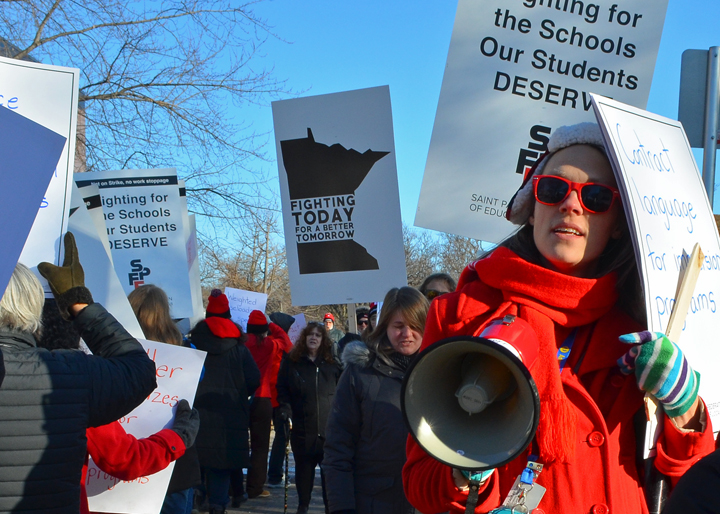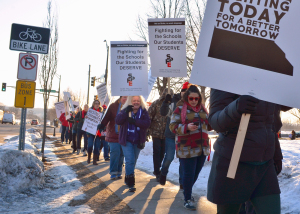

Share
What would 3,600 St. Paul teachers, educational assistants and licensed professionals on strike look like?
Minnesota’s second-largest school district got a preview Wednesday morning, when members of the St. Paul Federation of Educatorsheld informational picketing outside many school facilities.
Later in the day, educators delivered notice to the district that unless they make progress in upcoming negotiations, the picket lines will be back March 10 – this time for the first teachers strike here since 1946.
SPFE leaders say they hope the strike deadline will force school administrators to match the urgency educators have been bringing to contract negotiations since talks began last May, when union members began bringing forth 31 proposals to address the needs they see in their classrooms each day.
Educators are demanding a contract that guarantees their students more mental-health supports, that ensures non-English speaking families can access school services and that reduces special-ed caseloads.
And SPFE members are willing to strike, if necessary, to force the district to address those concerns at the bargaining table.

SPFE members and community supporters line the sidewalk outside Highland Middle School.
In a strike-authorization vote Feb. 20, rank-and-file members signaled strong support for their bargaining team. About two-thirds of all members participate, according to SPFE, and 82% voted “yes.”
“Nobody wants to go on strike,” the union’s executive board wrote in an e-mail to members announcing the vote results. “That is why we’ve spent nearly a year engaging with the district on our student-centered proposals and on wages and benefits for our members.
“However, we refuse to accept the district’s position that our students and educators already have access to all of the supports they need to thrive.”
Teachers strikes have swept across the country over the last two years, as the #RedForEd movement pushes officials to address decades of disinvestment in public schools and the working people who staff them.
Last year alone, 237,400 teachers in North Carolina, West Virginia, Los Angeles, Chicago, Kentucky and Oregon went on strike, fueling a historic surge in major work stoppages. Federal labor statistics released last week show the average annual number of workers participating in major strikes over the last two years – 455,500 – reached a 35-year high.
Long before the #RedForEd wave swept the country, though, St. Paul was the site of the first organized teachers strike in U.S. history, a 30-day work stoppage between Thanksgiving and Christmas of 1946.
The city’s female teachers, members American Federation of Teachers Local 28 (still on SPFE’s union charter today), led the charge not just for pay increases, but a more equitable allocation of school resources and new investments in school facilities. They called it the “Strike for Better Schools.”
Today, it’s a fight for the “Schools St. Paul Students Deserve.”

